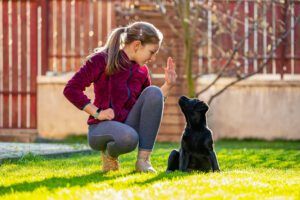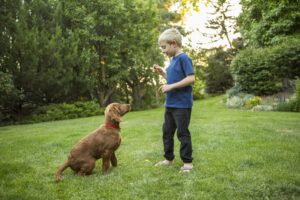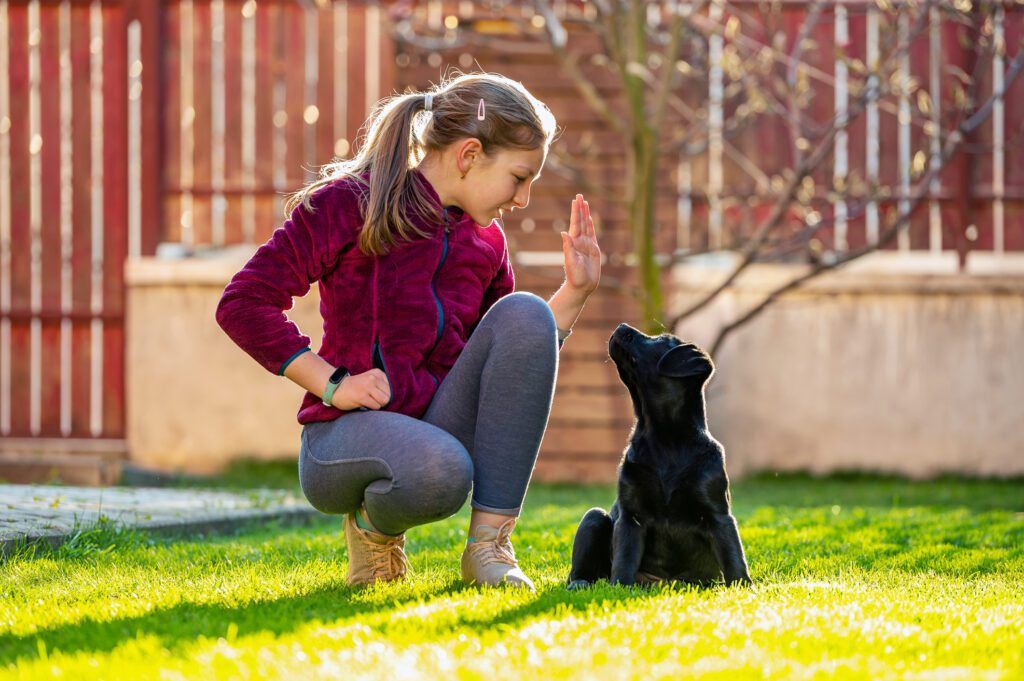
It makes good sense to have your offspring participate in your dog’s training program. After all, the kids and dogs in the household often spend the most time together. The level of your children’s participation in your dog’s training program will vary based on the age and abilities of the children. But even a toddler can hand feed a treat (or toss it on the floor if your dog takes treats too eagerly or with a hard mouth) when you mark your dog’s correct behavior in response to a cue, and the most dog-obsessed kids may even be able to do some of the training themselves under your direct supervision. Older children can do the training by themselves after they’ve been instructed by you or your trainer and you are confident that they are capable of doing it correctly.
Initial ground rules: Respecting the dog

I’m a huge fan of enlisting kids to help with the dog’s training at the earliest possible age, using positive reinforcement-based methods that teach children the importance of cooperation and respect. This interaction also strengthens the positive association between your dog and your child. Before you engage your child to assist with your dog’s training, however, they need to learn how to respect and interact appropriately with dogs (and other sentient creatures). It’s vitally important to teach children four important safety rules:
-
- Dogs are not toys to be treated roughly or with anger.
- Dogs have the right to keep their own possessions. Do not take bones, toys, or blankets away.
- Dogs are not to be bothered when they are eating.
- If the dog “asks” them to stop doing something (with body language such as stiffening, moving away, or growling), they must stop immediately.
If followed, these rules should keep your children and dog safe (because a dog who hurts a child in self-defense is likely to be surrendered or euthanized). If a child is too young to grasp these rules, the supervising adult must physically prevent the child from being inappropriate. For more about kid/dog safety, see “Kids and Dogs,” WDJ August 2019.
First Training Step: Practice Known Behaviors

If your dog has already learned some behaviors, start with those. Teach your child the verbal cue for an easy behavior like “sit” (and the hand signal if the dog knows one) and then show her how to get the dog to respond. Although your dog may perform the behavior reliably for you, he may be a bit confused when the cue comes from a child. If that’s the case you can prompt or lure the behavior after your child gives the cue, and then teach her how to prompt or lure if appropriate (if she is old enough and capable).
Introducing your child to your dog’s known “sit” behavior might look something like this:
-
- Tell your child what cue she will be using – in this case, “Sit!”
- Explain that when the dog sits, the behavior gets marked and he gets a treat (depending on the child’s age and capabilities you may use a clicker or a verbal marker, such as the word, “Yes!”). Be sure to explain that you have to give a treat when you mark, so the marker must only be used when the dog has done what you’ve asked. If you’re using a clicker, and your youngster delights in running around the house clicking, you may need to put the clicker away when you’re not actively training!
- Have your child practice marking and then giving a treat to an imaginary dog (or a stuffed one!) before asking her to try it with your live dog. (If your dog is grabby for treats, have your child drop the treat on the floor.)
- Demonstrate (a few times) the sequence with your dog: Cue the sit, mark when he sits, and feed the treat – preferably moving the treat quickly to his lips so he is still sitting when he eats it. Demonstrate also how to prompt or lure if he doesn’t sit when you ask him to.
- If your child is old enough to be physically capable, have her practice the sequence. If she’s not old enough, keep giving the cues and marking and have your child feed or toss the treats, letting her participate more and more as she is able. The next step might be having her click the clicker or say “Yes!” after you’ve cued the dog and he sat.
- Eventually show your child how to practice all the behaviors your dog already knows. I recommend creating a vocabulary list of all your dog’s known cues and posting them on the refrigerator for all family members who are participating in the training program to refer to so cue usage is consistent.
Teach New Behaviors
Older kids can certainly play a leading role in teaching new behaviors to the family dog, but even the younger ones can participate in the process. How much depends, of course, on both the child and the dog, but all ages of children can take pride in knowing they have taught the dog something new.
The process for teaching new behaviors is similar. Here’s how you might show your child how to teach a new “down” behavior:
-
- Explain what cue you will be using (“Down!” – or…?), what you want the behavior to look like (dog is lying all the way down on the ground), and how you plan to help the dog understand what you want him to do (whether luring, capturing, or shaping…). Discuss “lure-shaping” – where you use a treat to get the dog to do small pieces of the behavior, encouraging him to lower his front end, marking and treating as you go, gradually getting closer and closer to the final behavior. For more about lure-shaping see “Fun Dog Training Techniques Using Shaping,” WDJ Feb 2006.)
- Demonstrate the process, starting with the dog sitting. Put the treat in front of his nose lower it a little bit, mark and treat as he follows it.
- Repeat, gradually lowering the treat closer to the ground with multiple repetitions. (For a step-by-step tutorial, see “How to Teach Your Dog to Lie Down on Cue.”) Depending on your dog’s level of cooperation and your child’s abilities, you may be able to have her take over after a few repetitions of the demonstration with you continuing to coach, or you may need to continue participating more fully in the process. That’s your judgment call.
- Now, expand your dog’s repertoire. Let your child help decide what new behaviors they want to help teach – and be sure to include tricks! Tricks are fun for all and are guaranteed to help strengthen the dog-child bond.
Also, be sure to show your young ones how to incorporate training into every day activities, using real-life rewards when appropriate. “Sit and I’ll throw the ball for you.” “Sit and we can play tug.” “Lie down and I’ll open the door for you to go out in the back yard.” “Sit and I’ll put your food bowl down.”
Supervise!

Young children should, of course, always be supervised when they are in the presence of the family dog. “Supervision” means not just being in the same room, it means also having eyes and mind on the dog-kid combination at all times. You constantly make sure the child is appropriate with the dog, and constantly watch and interpret the dog’s body language to make sure he is comfortable with the child. This iron rule is especially unbendable when the dog and child are actively engaged with each other – for example, if the child is playing with or training the dog. Not only do you want to be sure that the child is safe, you also want to be sure the dog is enjoying the interaction and the training is being successful.
While older children don’t need the constant close scrutiny that young children do, you still want to be sure the training is going well and being done correctly. Check in with the dog-kid combination on a regular basis to reassure yourself that your learners are enjoying themselves and that training progress is happening.
So – how old is “younger” and how old is “older”? It is suggested that children aged 6 and under require constant close supervision, ages 7 to 12 are more capable of being dog-appropriate with less supervision, and 13 and up are generally mature enough to be trusted with the dog. Of course, each child is an individual and you’ll need to make your own judgment calls for your own offspring, but I would urge you to err on the side of caution. It’s far better to over-supervise than under-supervise.
Protected Contact
You might consider using “protected contact” in your training program with your dog and young child. The concept of protected contact is widely used in zoos, where animal care attendants keep a safety barrier between themselves and dangerous animals who might injure them – or worse. You can do the same with a child who might be overwhelmed or inadvertently injured by an over-exuberant canine subject. You could have your child work with the dog on a tether, inside an exercise pen or the other side of a baby gate. It can also be helpful to make sure your dog is well exercised before engaging in a training session with a young child. Too much enthusiasm on the part of the canine learner can damage the dog-child relationship – which is the exact opposite of the goal we are trying to achieve.
You Might Be Surprised
Obviously, older children will tend to catch on more quickly and be able to participate more fully in your dog’s training than very young children. But don’t sell your little ones short – some young children can be surprisingly adept at learning and applying training skills. Our trainers are frequently impressed by how well some of their junior students do in their dog training classes – often better than the adults! Do remember to keep it fun – the goal is to strengthen the bond – and that’s most likely to happen if all species involved are enjoying themselves.

2 Comments